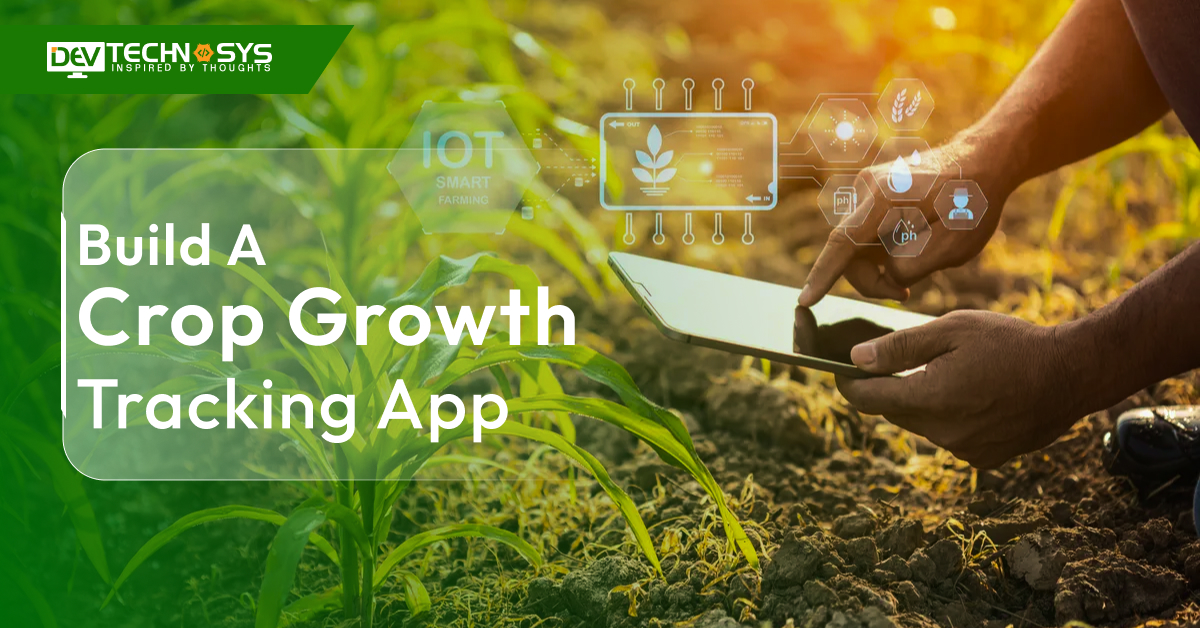“Healthy Crops, Higher Profits”
In this modern era, the farming sector remains unaware of the latest technologies and applications that help to manage their operations, especially to track the crop growth in real-time.
This time, smart farming wins, hard work just helps.
There are many crop growth tracking applications that help farmers track crop growth, weather conditions, soil health, pest control, and growth stages.
As per the global study, the crop growth tracking applications market is valued at around $2.61 billion in 2024. This is projected to increase to around $5.77 billion by the end of 2030.
This useful information shows how rapidly these applications are ruling the market and why businesses invest in crop growth tracking app development.
Just read the blog to clear how to build a crop growth tracking app, basic and advanced features, overall development cost, and many more.
What is the Crop Growth Tracking App?
A Crop Growth Tracking App is a digital application that helps farmers monitor and manage their crops more successfully. It uses sensors, satellite imaging, and artificial intelligence to deliver real-time data on growth phases, soil health, meteorological conditions, and insect activity.
An app like FarmRise helps farmers make wiser farming decisions, increases crop yields, minimizes resource waste, and boosts overall agricultural production by providing timely insights.
- Real-Time Growth Monitoring
- Weather Forecast Integration
- Soil Health Analysis
Market Analysis of Crop Growth Tracking Applications
- In 2024, the crop growth tracking apps market is expected to be worth around $2.61 By the end of 2030, this is expected to rise to almost $5.77 billion.
- From 2024 to 2030, the worldwide smart crop monitoring market is anticipated to expand at a compound annual growth rate of 1%.
- In 2023, the market was led by the hardware sector, which generated over 0% of worldwide revenue.
- AGCO Corporation, CLAAS Group, Climate LLC, Deere & Company, Microsoft Corporation, and Prospera Technologies are a few of the companies that are involved in the smart crop monitoring sector.
- The United Nations Department of Economic and Social Affairs reported that by 2050, there would be 8 billion people on the planet.
![]()
10 Popular Crop Growth Tracking Apps
Discover the top ten Agtech apps, which provide farmers with real-time monitoring, pest detection, weather updates, and sophisticated analytics to increase production and improve agricultural operations throughout the world.
![]()
| Applications | Download Users | Stores Ratings | Apps Launched On | Platform Accessibility |
| Plantix | 10M+ | 4.6 | 2015 | Android |
| AgriApp | 1M+ | 4.4 | 2016 | Android/iOS |
| CropIn | 500K+ | 4.2 | 2010 | Android/iOS |
| AgFunder | 100K+ | 4.3 | 2013 | Android/iOS |
| FarmLogs | 500K+ | 4.5 | 2011 | Android/iOS |
| TaniHub | 1M+ | 4.2 | 2015 | Android/iOS |
| Climate FieldView | 100K+ | 4.0 | 2015 | Android/iOS |
| AgriWebb | 100K+ | 4.3 | 2014 | Android/iOS |
| AgriSync | 50K+ | 4.6 | 2016 | Android/iOS |
| e-Choupal | 100K+ | 4.1 | 2000 | Android/iOS |
Why Businesses Want to Build a Crop Growth Tracking App?
Businesses invest in field service mobile app development to tap into precision agriculture, monetize data, foster farmer loyalty, support sustainability, and gain a competitive edge through innovation, unlocking new revenue streams while meeting the evolving needs of modern farming.
- Increased Need for Precision Agriculture
- Data Monetization Opportunities
- Increase Brand Loyalty
- Support for Sustainable and Traceable Farming
- Competitive Advantage
![]()
1. Increased Need for Precision Agriculture
Modern farmers are increasingly reliant on technology to maximize yields and avoid waste. Crop growth tracking applications help farmers make better decisions by providing data-driven insights into soil health, weather trends, and insect detection. By providing this value, organizations may get into the expanding precision agricultural sector, which is expected to exceed $20 billion by 2026.
2. Data Monetization Opportunities
If businesses develop an agritech mobile app, it can capture massive quantities of useful agricultural data, such as crop performance, soil condition, and weather patterns.
Businesses can utilize anonymised data to provide insights to agricultural input firms, research organizations, and politicians. This data may be monetized through partnerships, subscription models, or targeted services, resulting in a consistent cash stream.
3. Increase Brand Loyalty
Agritech firms and agrochemical manufacturers employ applications to establish direct digital connections with farmers. Businesses may increase consumer trust and loyalty by providing helpful features such as crop tracking, pest alarms, and harvest projections. It also enables timely push alerts and targeted offers depending on user behavior.
4. Support for Sustainable and Traceable Farming
Consumers and governments are seeking greater openness in the food supply. Crop monitoring software enables organizations to assure traceability from farm to fork by recording growth phases, input consumption, and harvesting dates. This transparency promotes sustainability activities and may serve as a selling feature in both B2B and B2C sectors.
Interested in a chatbot demo, pricing, or more info? Fill out the form our expert will contact you shortly.
-
Chatbot Demo
-
Cost to Develop an app
-
Industry Report
-
Case Study
5. Competitive Advantage
As the agricultural business grows increasingly technologically advanced, early users of digital instruments have a competitive advantage. Launching a crop tracking app demonstrates innovation and attracts partners, investors, and customers.
The crop monitoring Android app development solutions enables firms to stand out in a crowded market by providing value-added services beyond standard agricultural support.
How AI Can Help Crop Growth Tracking Applications?
- AI predicts crop diseases early by analyzing patterns from sensor and image data, enabling timely interventions.
- AI optimizes irrigation schedules by analyzing weather, soil moisture, and crop needs to save water and boost growth.
- AI analyzes soil health and nutrient levels, recommending precise fertilizer applications to improve crop productivity.
- AI automates growth stage monitoring, reducing manual labor and providing consistent, real-time crop status updates.
- It predicts optimal harvest times by analyzing growth trends and environmental factors for improved yield quality.
7 Robust Steps to Build a Crop Growth Tracking App
To build a crop growth tracking app, it requires strategic planning, from understanding farmers’ needs and defining key features to selecting the right technology, designing user-friendly interfaces, integrating real-time data, thorough testing, and providing continuous support. So, here we offer the crop growth tracking mobile app development process:
- Conduct Market Research
- Define Core Features
- Choose the Right Technology Stack
- Design Intuitive UI/UX
- Develop and Integrate Features
- Test Thoroughly
- Launch and Support
![]()
1. Conduct Market Research
Understand the needs of farmers and agronomists by analyzing existing crop tracking solutions. Hire dedicated developers to identify gaps and gather user feedback to design an app that effectively addresses real-world agricultural challenges and improves crop management.
| Who is the target audience for the app? |
| What existing crop tracking solutions are available? |
| What are farmers’ biggest pain points? |
2. Define Core Features
List essential features such as real-time growth monitoring, weather updates, pest detection, soil analysis, and notifications. Prioritize functionalities that maximize usability and enhance farm productivity based on target user requirements.
| What are the must-have features for the app? |
| Which features improve crop monitoring accuracy? |
| Should the app include weather updates? |
3. Choose the Right Technology Stack
In the third stage to develop a crop growth tracking app, mobile app developers for hire to select appropriate technologies for mobile development (e.g., Flutter, React Native), backend infrastructure (Node.js, Django), and data integration tools like IoT sensors or satellite imagery for accurate crop data collection.
| Which mobile platforms should the app support? |
| What backend technology suits real-time data needs? |
| Which database best handles large agricultural data? |
4. Design Intuitive UI/UX
Create a user-friendly interface tailored for farmers, focusing on easy navigation, clear data visualization, and minimal learning curve to ensure the app is accessible to users with varying technical skills.
| Which data visualizations best represent crop growth? |
| Is the design readable in outdoor lighting? |
| What color schemes improve usability and focus? |
5. Develop and Integrate Features
Let’s move to the fifth stage to create a crop growth tracking app. Android app developers for hire to build the app’s front and back and integrate APIs for weather and satellite data. Connect IoT devices for soil and crop monitoring, ensuring real-time and reliable data flow to users.
| How will core features be implemented technically? |
| How will IoT devices be connected to the app? |
| Which APIs are needed for weather and satellite data? |
6. Test Thoroughly
Conduct extensive testing, including functional, usability, performance, and field testing with actual farmers, to identify bugs, gather feedback, and refine the app for stable and accurate performance in real agricultural environments.
| Have all core features been tested for functionality? |
| Are there any bugs or crashes during app use? |
| How intuitive is the user experience during testing? |
7. Launch and Support
Let’s connect to last stage of Android or iPhone app development process, release the app on relevant platforms, provide user training and support, and collect ongoing feedback. Continuously update the app with new features and improvements based on user needs and technological advancements.
| Is the app ready for public release? |
| Have all launch platforms been prepared? |
| What support channels are available post-launch? |
Simple and Advanced Features of Crop Growth Tracking Apps
These features empower farmers with actionable insights, enhance productivity, and support sustainable farming practices.
![]()
1. Real-Time Crop Monitoring
These applications use satellite images, IoT devices, or manual inputs to offer farmers with the most recent information on crop health, development phases, and environmental variables.
2. Weather Forecast Integration
Weather forecasts, such as rainfall, temperature, and humidity, help farmers arrange irrigation, pesticide spraying, and harvesting schedules more effectively.
3. Pest and Disease Detection
AI-powered picture recognition and expert systems aid in the detection of insect infestations or plant diseases, allowing for timely treatments to reduce losses.
4. Soil Health Analysis
Users may record and track soil characteristics such as pH, moisture levels, and nutrient content to provide the best growth circumstances for various crops.
5. Alerts and Notifications
If you build an app like Plantix, it allows farmers to take preventive actions by receiving timely reminders and warnings about weather changes, pests, and watering needs.
6. Growth Stage Logging
Farmers may monitor each crop’s development phase—sowing, germination, blooming, and harvesting—to better plan interventions and anticipate yields.
7. Geotagging and Field Mapping
GPS and satellite technologies enable users to define field borders, map crop regions, and track particular zones for targeted operations.
8. Irrigation Management
These applications recommend watering regimens depending on crop type, soil moisture, and weather forecasts, therefore saving water and boosting plant health.
9. Yield Prediction and Analysis
Using historical data and real-time inputs, the software can anticipate projected yield, which aids in storage, marketing, and supply chain planning.
10. Data Synchronization and Offline Access
Syncing data between devices and allowing offline capability allows customers to follow their crops even in distant places with limited internet.
The Cost to Build a Crop Growth Tracking App
The cost to develop a crop growth tracking app typically ranges from $8,000 to $25,000, depending on complexity, features, and platform (Android, iOS, or both). Basic apps with core features like weather updates and manual crop logging fall on the lower end.
Advanced apps with AI-based pest detection, GPS mapping, and real-time data sync push the cost higher. Ongoing expenses for maintenance, cloud hosting, and updates also add to the overall budget, especially for enterprise-scale or data-driven solutions.
Cost to Build a Crop Growth Tracking App
| Crop Growth Tracking App Development
|
Estimated Cost | Time Frame |
| Basic App Development
|
$8000 – $12000 | 2 to 4 Months |
| Mid-Premium App Development
|
$14000 – $19000 | 5 to 8 Months |
| High-Premium App Development
|
$25000+ | 9+ Months |
5 Major Factors That Affect the Crop Growth Tracking App Development Cost
Factors affecting crop growth tracking app development cost include feature complexity, platform choice (Android, iOS, or both), integration of advanced technologies like AI and GPS, backend infrastructure, design quality, development team location, and ongoing maintenance needs. These elements collectively determine the overall investment required for a robust app.
![]()
1. Simple and Premium Features
Basic apps that provide essential services, such as crop logging and weather updates, are less expensive to design. Adding premium features like AI-powered pest detection, GPS mapping, analytics, and interaction with IoT devices greatly increases the cost to develop a smart farming app. To maximize ROI, feature selection must strike a balance between user demands and financial restrictions.
| Basic Features | Estimated Cost | Advanced Features | Estimated Cost |
| Crop Diary / Logbook | $6,000 – $9,000 | AI-based Pest & Disease Detection | $4,000 – $7,000 |
| Weather Forecast | $4,000 – $7,000 | Satellite & Drone Imagery | $3,000 – $5,000 |
| Task Reminders | $8,000 – $12,000 | IoT Integration | $10,000 – $14,000 |
| Soil Condition Notes | $7,000 – $11,000 | GPS-Based Field Mapping | $7,000 – $10,000 |
| Crop Calendar | $10,000 – $12,000 | Yield Prediction Analytics | $10,000 – $15,000 |
2. Development Team
The development team’s experience, size, and location all have a significant impact on cost. Hiring skilled engineers, UI/UX designers, and QA specialists from areas with higher living costs typically raises prices. Offshore teams may lower expenses, but they require good communication to assure quality and timely delivery, which affects the entire budget.
| Developers Experience level | United States | United Kingdom | Southeast Asia | Eastern Europe |
| Junior-level | $15 – $25 | £14 – £24 | $12 – $22 | $10 – $20 |
| Mid-level | $30 – $50 | £27 – £44 | $25 – $35 | $25 – $33 |
| Senior-level | $60 – $80 | £50 – £65 | $40 – $55 | $40 – $50 |
3. Application Design
User-friendly and straightforward design is essential for farmer uptake. Custom, visually appealing UI/UX designs demand more effort and specialist designers, which increases prices. Incorporating interactive components, offline mode, and accessibility features adds complexity while improving user engagement and pleasure, making the investment worthwhile.
| Design Quality | Cost Estimation |
| Basic Design | $8,000 – $12,000 |
| Complex Design | $15,000 – $22,000 |
4. Backend Development
A reliable backend is required for real-time data processing, user administration, and cloud integration. Complex backend systems with APIs, databases, and server infrastructure raise the cost. Scalability and security requirements drive up costs, as firms want dependable performance and data protection for critical agricultural information.
| Backend Complexity | Estimated Cost (USD) | Estimated Time |
| Basic Backend | $5,000 – $10,000 | 3 – 6 weeks |
| Advanced Backend | $10,000 – $18,000 | 6 – 10 weeks |
5. Support and Maintenance
Bug patches, upgrades, and compatibility enhancements with newer operating system versions are all part of post-launch maintenance. Continuous maintenance assures the app’s functionality and security, which necessitates the use of dedicated resources.
Businesses must budget for long-term support to address changing user demands and growing technological trends, which affect the overall cost to develop an agriculture app like AgriApp.
| Service Level | Description | Estimated Annual Cost (USD) | Estimated Time |
| Basic Support | Bug fixes, minor updates | $3,000 – $6,000 | Ongoing |
| Comprehensive Support | Frequent updates, performance optimization | $6,000 – $9,000 | Ongoing |
How to Generate Revenue Streams From Crop Growth Tracking Apps?
App developers may increase value for farmers and other agri-stakeholders while ensuring sustainability by integrating various income streams.
- Freemium Model
- Subscription Plans
- Data Monetization and Insights
- Partner Integration and Affiliate Marketing
- Advertising-Based Revenue
![]()
1. Freemium Model
Offering the software for free with basic functionality draws a large user base, particularly small and medium-sized farms. Advanced capabilities, such as AI-powered pest identification, satellite mapping, and production forecasts, may require a premium subscription.
To gain access to these additional capabilities, users can make in-app purchases or subscribe. This tiered method broadens reach while monetizing serious consumers.
2. Subscription Plans
Monthly or annual subscription models provide steady revenue from consumers who use the program on a regular basis. These programs may be tailored to various user groups, including individual farmers, agronomists, cooperatives, and agribusinesses.
Higher-tier subscriptions may feature analytics dashboards, multi-farm administration, offline data synchronization, and real-time professional help, making them more appealing to business customers.
3. Data Monetization and Insights
A farm platform like Fresh Harvest can capture essential agricultural data such as weather patterns, crop health trends, insect incidences, and soil profiles.
This anonymized data may be monetized by selling insights to agritech businesses, input manufacturers, research institutes, and government entities. These firms utilize such data for research and development, market analysis, and legislation, creating a scalable B2B income opportunity.
4. Partner Integration and Affiliate Marketing
Collaborating with agrochemical businesses, seed suppliers, or equipment manufacturers enables affiliate advertisements within the app.
Recommending certain items depending on the user’s crop stage or problem might generate commission-based revenue while providing value to farmers through customized advice.
5. Advertising-Based Revenue
For free users, appropriate and non-intrusive adverts from agribusinesses or farming companies can be a source of money. According to the mobile app development company, these can be display advertisements or sponsored material, such as advice or lessons, that are specific to the farmer’s current agricultural operations or area.
Conclusion
In conclusion, building a crop growth tracking app helps farmers monitor their crops easily and make better decisions. It includes features like weather updates, soil health, and plant growth records.
With the help of an AgTech software development company, we can create useful apps that support smart farming. These apps can increase crop yield and save time.
Technology in farming is growing fast, and this kind of software is very helpful. In the future, more farmers will utilize such apps to cultivate healthy and robust crops.
Frequently Asked Questions
1. How Much Does it Cost to Build a Crop Growth Tracking App?
The cost to develop a crop growth tracking app ranges from $8,000 to $25,000 or more, depending on features, design, platform, and whether you hire a crop growth tracking app development company or freelancers.
2. How Much Time Does It Take To Create a Crop Growth Tracking App?
To create a crop growth tracking app, it normally takes 3 to 6 months, depending on features, complexity, and team size. Basic versions are quicker, while advanced apps with analytics, IoT integration, or AI take longer.
3. Which Technologies Are Used to Make a Crop Growth Tracking App?
To make a crop growth tracking app, there are various trending technologies used, such as React Native or Flutter for mobile development, Node.js or Django for backend, PostgreSQL for databases, satellite APIs, IoT integration, and AI/ML for predictive analytics and monitoring.
4. Can the App Integrate With Farm Management Systems?
Yes, the app can integrate with farm management systems via APIs, enabling seamless data exchange, real-time updates, automated workflows, and centralized control to improve operational efficiency and provide comprehensive insights across farming activities.
5. Is Offline Functionality Important?
Yes, offline functionality is crucial for crop tracking apps, allowing farmers to access and record data without internet. It ensures continuous monitoring in remote areas, syncing automatically once connectivity is restored for reliable, uninterrupted use.






























